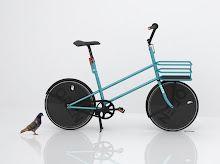Traffic congestion in the Dutch capital, including a Prius and a bunch of brand new cars. From The Hamperium.
A video from Mark Wagenbuur in the latest post at Copenhagenize is an extremely dangerous (way to talk about) history. Please watch it before proceeding.
First of all, in response to Mikael Colville-Andersen's brief comment, a comparison of the situation which "vehicular cyclists" deal with (and perhaps enable to some extent) with that in the Netherlands leaves out at least one alternative...
I love what Mark Wagenbuur does. Many videos on his You Tube Channel are also on the excellent A View From the Cycle Path (this a direct link to a post with another great Wagenbuur video), often accompanied by interesting comments.
The not-recent history of surface transport in the Netherlands is mostly new to me (and I appreciate this very much). The problem in the story starts with railways, which - relatively-speaking - introduce a kind of precursor to or early-stage hypermobility to the country. Trains, like trams, increased the distances between destinations, making speed necessary to compete, and thus addictive. But until various decades in the first half of the 20th century this still kept cycling popular and/or dominant.
The fatal error came - as the video shows, but with a different take on it - when cities introduced a design style from the countryside. It seems that this was not seen as a fatal error by enough people at the time: Either there were three options in the cities (i.e. keep streets the way they are OR separation for cyclists OR keep the motorized vehicles out) or just the first two. The video does not make clear exactly who made the decision. Were people predicting the situation about 50 years later in the 1960's (my understanding is that this was the nadir of cycling in the NL as well as in Denmark)? If so, were their voices ignored? If there were not many voices - and so not three choices - it is fair to say that this was bad and wrong, but we must also appreciate everything which has been done to fight back (very much including the new design elements in the video which I provide the link to in the Hembrow blog).
So, these days, when at its best cycling modal share is about 50% (as it is Groningen in the north of NL) and innermost parts of Amsterdam, Copenhagen etc.) is the glass half-full or half-empty? This beverage also contains collective public transport (nearly and chronically ignored in some cycle-cheerleading), but what if the non-PT and walking split is half private automobiles and half bicycles? Should we be half-happy or half-sad? (re: cheerleading, notice how that story does not mention collective PT?) It depends on who is writing or showing the history, yes? Indeed, could the private automobile lobby show a video on their You Tube channel, boasting about how they have managed to hold on to a huge modal share despite all the traffic jams, parking costs, "green" and health issues?
Cycling in the Netherlands is great - safer, etc. than here in Germany, where the separation model has been used often at the expensive of pedestrians - but I don't think it is accurate to say that the bicycle has "won" there (as someone told me recently). It is more truthful - and more objective - to say that the car has had a (very) conditional surrender (I am reminded also of something my father told me: During WWII - my Slovak father was a tween/teen at the time - the German radio referred to everything post-Stalingrad as a "strategic withdrawal").
Still, there is news which we can agree is good and which deserves strong praise: The bikes move faster than motor vehicles much of the time on separated paths in cities when the motorised lanes are congested, so actually these paths can more positively be called "mobility express lanes" (not just "bicycle highways")! But at the same time there are still a very high number of people trapped in their cars, and they are not the only ones who are suffering. Noise and gas/particle emissions still exceed allowed limits in parts of the Netherlands (and Denmark, and of course in many other European countries), and this hurts everyone.
Looking back over 100 years it is perhaps easy to condemn a decision, or how it was made, or indeed if anyone cared, but allowing (especially private) motor vehicles (which kill on contact at only half of their design speed) inside cities was a mistake, and is proving a very, very difficult one to correct.
Looking back over 100 years it is perhaps easy to condemn a decision, or how it was made, or indeed if anyone cared, but allowing (especially private) motor vehicles (which kill on contact at only half of their design speed) inside cities was a mistake, and is proving a very, very difficult one to correct.






